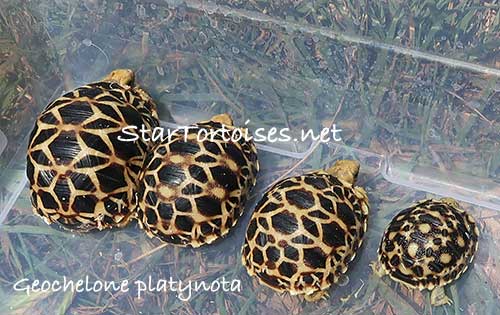


Burmese star tortoise hatchlings are the cutest tortoise babies. They are active, adorable, and have beautifully patterned shells. Little jewels. :0)

Freshly hatched Burmese star tortoise baby. Notice the egg tooth on his upper beak.

These two Burmese star tortoise babies show the variability of shell patterns at birth.

Freshly hatched Burmese star tortoise with an older sibling from a previous clutch.

Pattern development. Burmese star tortoise babies of various ages. The youngest one is freshly hatched and the oldest one is six months old.
My angulates and golden Greeks nest during the daylight hours, but the Burmese star tortoises like to start in the afternoon and stretch the process into late evening or into the dark hours of the night.

Fortunately, that night the soil was wet from a recent rain so the nest digging went faster than usual for this Burmese star tortoise lady. Though, she didn't finish covering her nest until about 11 PM when the temperature was barely above 50 °F. When the sun went down and it got colder, I placed a basking lamp above her to keep warm and flexible. Without the additional heat, she would have gotten stiff and slow. If you look closely you can see that she's pulled her head inside the shell. That's because she's in labor and in the middle of pushing an egg out.

I stayed outside in the cold and darkness with her. Brrr. It was so cold and somewhat windy that I had to put on a hat and three layers of clothing, but she stayed warm and cosy under her heat lamp. I did not want to disturb her egglaying, so I dug out part of the nest's back wall for easier egg retrieval. She laid 12 eggs.
Burmese star tortoise babies can be raised in open tubs with warm, humid hide areas or in vivariums (aka vivs, fully closed reptile cages, closed chambers, terrariums). Vivariums work well for tropical tortoise babies and those babies who don't like to burrow into warm, damp substrate or won't use humid hides.
In the near past, open tubs and tortoise tables were the typical way to raise tortoises while vivariums were frowned upon. However, in recent years vivariums have once again gained popularity among tortoise keepers, including Burmese star breeders, due to their ability to create a humid environment. Higher ambient humidity is especially beneficial for baby tortoises because it helps keep them hydrated and grow up with smoother shells.

Burmese star hatchling tub in a warm tortoise room. This baby is enjoying his first meal of dandelions. I put his crumbled eggshell in there as well. A plastic coffee can lid serves a very shallow water dish.
A warm, humid environment is important for babies to prevent dehydration and help the shells grow smoother. My babies like to dig into the thick layer of warm, damp New Zealand sphagnum moss. I check the dampness level of the moss at least twice a day. When needed, I pour some warm water into the moss and stir it up with my hands.
During the day, the moss is heated with a basking bulb and an on/off UVB tube. At night, a low wattage ceramic heating element (CHE) or a reptile radiant heat panel warms the damp moss from above, if needed.

High humidity vivarium (viv, fully closed reptile cage, closed chambers) for Burmese star tortoise babies. A very shallow water dish is on the left. A long UVB tube covers half of the viv length, incandescent bulb is used in the basking area, and LEDs provide additional light. Right side of the viv is bright with the UVB and LED lights. Left side is darker with more plant coverage for hiding, security, and escaping the bright lights. The door is only open for the photo.

Burmese star tortoise youngster watching the world go by through her vivarium window. No, she's not clawing and trying to get out of her enclosure. She's just checking out what's going on in the room. :0)

Vivarium for Indian star tortoise babies. Photo courtesy of Julius Guillaumey, France.